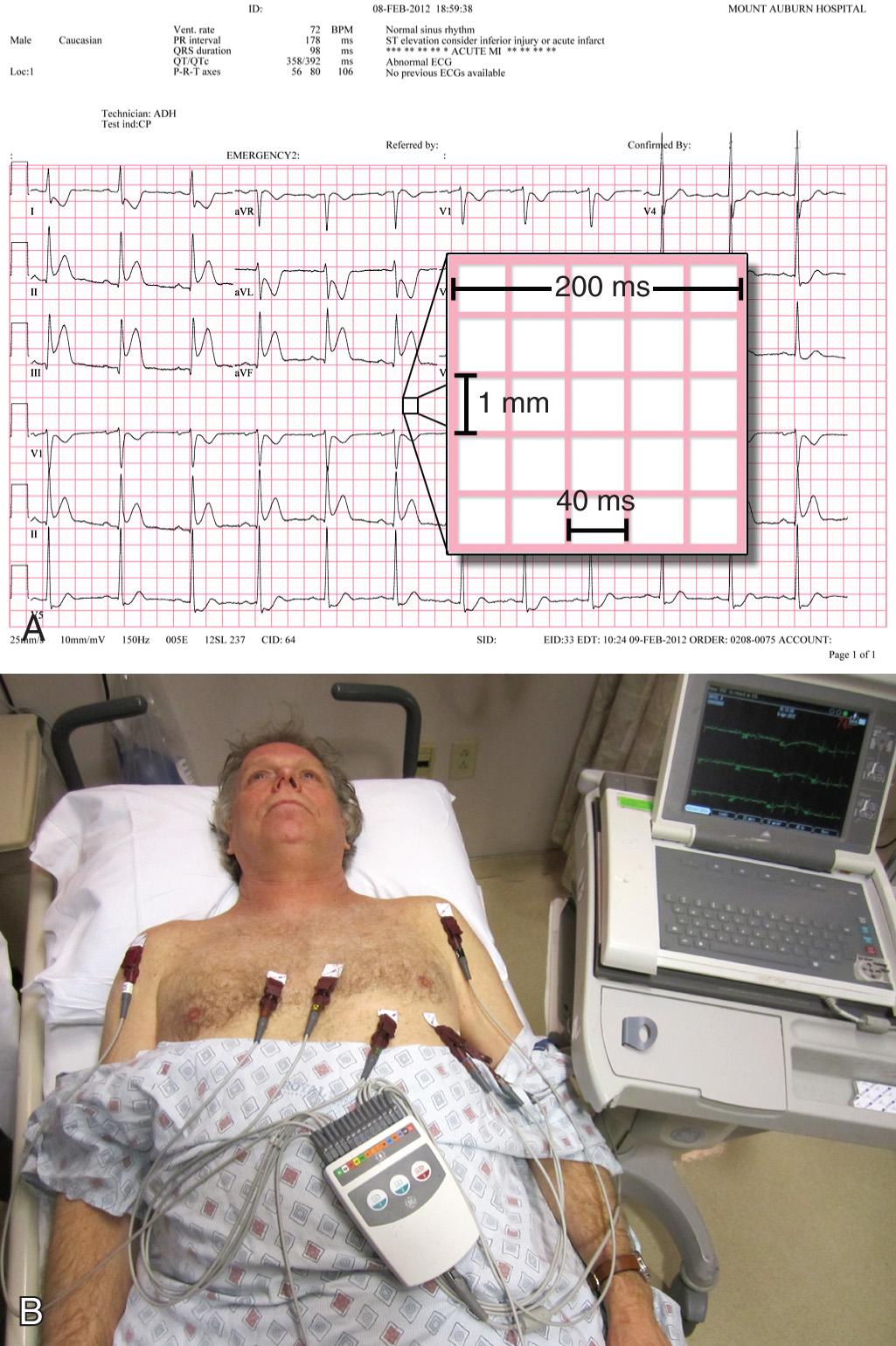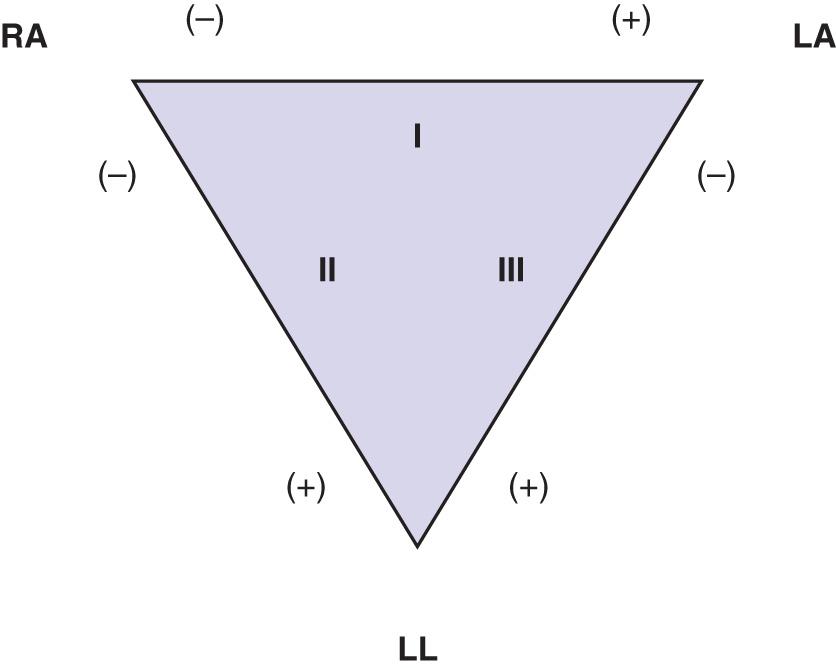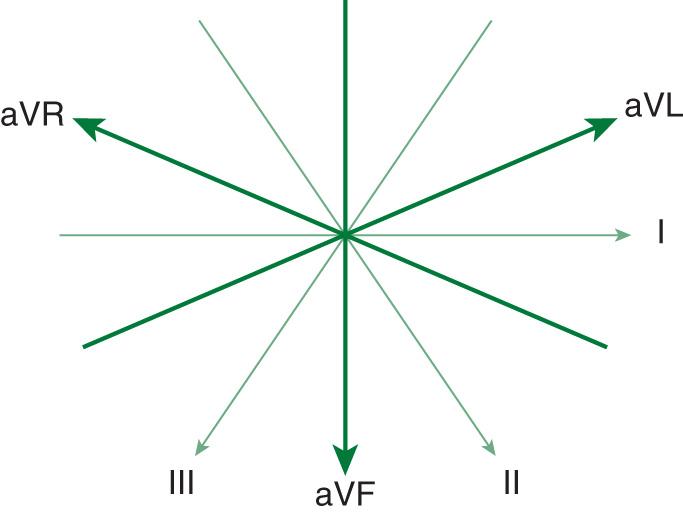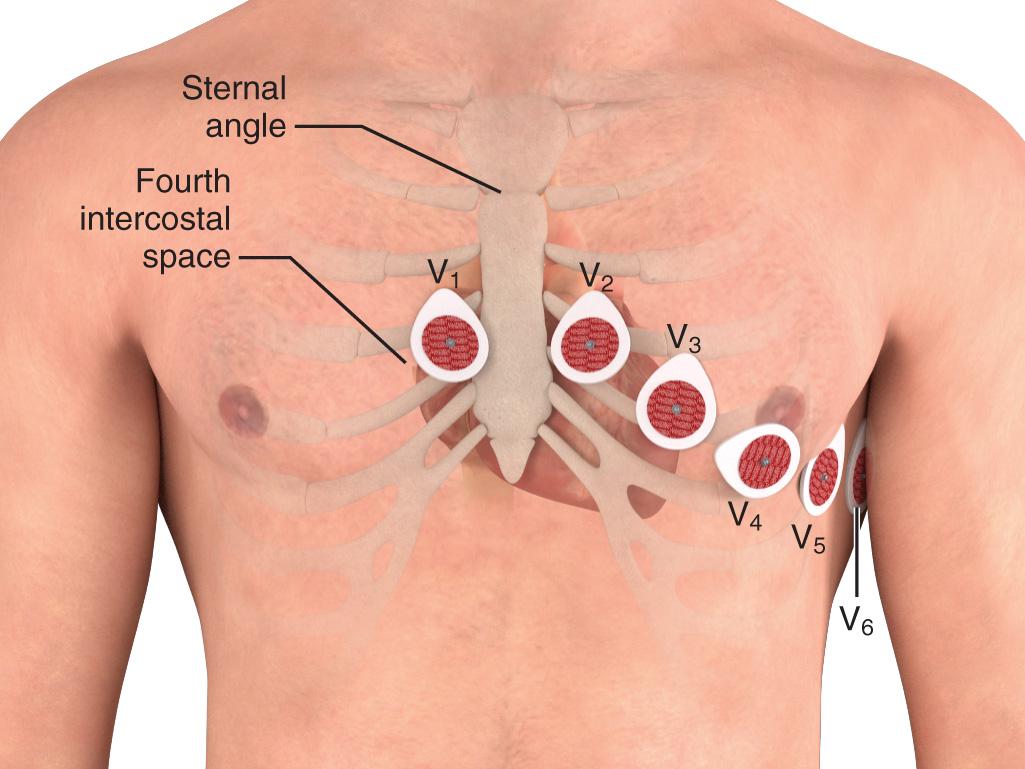Physical Address
304 North Cardinal St.
Dorchester Center, MA 02124
The electrocardiogram (ECG) is a graphic recording of the electrical activity of the heart. The standard ECG is obtained by applying electrodes over the chest and limbs to record the electrical activity of the cardiac cycle. Developed over 100 years ago, the ECG remains the most important initial diagnostic tool for the evaluation of patients presenting with chest pain, dyspnea, syncope, cardiac arrest, and toxicologic exposures, among many other clinical symptoms.
Electrocardiography is performed widely throughout the health care field, including ambulances, ambulatory clinics, emergency departments (EDs), and in-patient hospital units. Standard electrocardiography machines are small, self-contained, and portable, thus allowing them to be used in virtually any setting.
In 1903, Dutch physiologist Willem Einthoven first published his recordings of the cardiac cycle with a new device, the string galvanometer, an early version of today's electrocardiogram. Although others had previously recorded cardiac electrical activity, Einthoven's instrument laid the basis for modern clinical electrocardiography. He used bipolar leads, established standards for recording rate and amplitude, and initially described the deflections using the now familiar P , Q , R , S , and T , descriptors.
Thomas Lewis visited Einthoven's laboratory and recognized the potential clinical utility of the electrocardiography machine. Lewis became the leading authority on electrocardiography in the early 1900s and was instrumental in the development and clinical application of this new technology. His electrocardiographic description of atrial fibrillation demonstrated the clinical potential of this technology. In the early 1930s, Francis Wood and Charles Wolferth first reported the use of ECGs to differentiate cardiac and noncardiac chest pain. Along with Frank Wilson, their work also led to development of the unipolar “exploring” electrode, which measured electrical activity anywhere in the body with a zero-potential central terminal as a reference. These electrodes could be placed directly over the chest and formed the basis for the standard precordial leads.
In 1938, the American Heart Association in conjunction with the Cardiac Society of Great Britain established the standard six precordial chest lead positions (V 1 to V 6 ). These precordial leads, along with Einthoven's original bipolar limb lead system (I, II, III) and the augmented unipolar limb leads developed by Emmanuel Goldberger (aVR, aVL, and aVF) in 1942, make up the standard 12-lead ECG used today.
The most frequent indication for electrocardiography in the ED is the presence of chest pain; other common complaint-based indications include dyspnea, syncope, and palpitations. Beyond complaint-based reasons for ECG performance, one can consider diagnostic investigations of suspected illness (cardiac arrest, acute coronary syndrome [ACS], pulmonary embolism, and toxic ingestion) and system considerations (“rule out myocardial infarction [MI]” protocol, sedations monitoring, admission purposes, and operative clearance). The ECG is used to help establish a diagnosis, select appropriate therapy, determine the response to treatment, assist in correct disposition of the patient, and help predict risk for both cardiovascular complications and death.
The initial 12-lead ECG obtained in the ED can be an important tool for determination of cardiovascular risk and accordingly, the choice of in-hospital admission location. Brush and coworkers classified the initial ECG into high- and low-risk groups. The low-risk electrocardiographic group had normal ECGs, nonspecific ST-T-wave changes, or no change when compared with a previous ECG. High-risk ECGs had significant abnormalities or confounding patterns, such as pathologic Q waves, ischemic ST-segment or T-wave changes, left ventricular hypertrophy, left bundle branch block, or ventricular paced rhythms. Patients with initial ECGs classified as low risk had a 14% incidence of acute myocardial infarction (AMI), a 0.6% incidence of life-threatening complications, and a 0% mortality rate. Patients with initial ECGs classified as high risk had a 42% incidence of AMI, a 14% incidence of life-threatening complications, and a 10% mortality rate. Another approach to risk prediction involves simple calculation of the number of electrocardiographic leads with ST-segment deviation (elevation or depression), with an increasing number of leads being associated with higher risk. Along similar lines, the clinician is also able to predict risk with a summation of the total millivolts of ST-segment deviation; once again, higher totals are associated with greater risk.
The limitations of the ECG must be recognized. The ECG is widely reported to have a sensitivity for AMI of only approximately 55%; in one study of 1000 patients with ischemic symptoms, sensitivity improved to 68% with serial ECGs and monitoring of ST-segment trends. In another series, the sensitivity of the ECG for AMI ranged from 43% to 65% over a 12-hour period after the onset of ischemic symptoms, yet the negative predictive value of a normal ECG (defined as normal or with nonspecific changes or isolated fascicular blocks) for AMI did not improve above 93% during this period. In a large series of more than 10,000 patients evaluated for ACS, 19 (2%) patients—ultimately found to have an AMI—were inappropriately discharged from the ED. A nonischemic ECG emerged as one of five risk factors for that inappropriate disposition decision.
Although there is variability depending on the workplace, most ECGs in use today are three-channel recorders with computer memory. Such multichannel systems, which record electrical events in several leads concurrently, offer advantages over the antiquated single-channel recorder systems as follows: capturing transient events on multiple leads simultaneously; banking the data in computer memory for storage, comparison, and transmission; and allowing presentation of data on a single sheet of paper. The electrocardiographic tracing is printed in a standardized manner on standardized paper by the electrocardiograph, which has default settings regarding the speed at which the paper moves through the machine, in addition to the amplitude of the deflections to be made on the tracing ( Fig. 14.1 A ) . Electrocardiographic paper is divided into a grid with a series of horizontal and vertical lines; the thin lines are 1 mm apart, and the thick lines are separated by 5 mm. At the standard paper speed of 25 mm/sec, each vertical thin line thus represents 0.04 second (or 40 msec), and the thick vertical lines correspond to 0.20 second (or 200 msec). Recordings from each of the 12 leads are typically displayed for 2.5 seconds by default setting; the leads appearing horizontally adjacent to each other are separated by a small vertical hash mark to represent lead change.

The standard ECG includes 12 leads derived from 10 electrodes placed on the patient; each is color-coded and represented by a two-character abbreviation ( Table 14.1 ; see also Fig. 14.1 B ). Distinction is made between the terms lead and electrode with the former referring to the electrical view or perspective and the latter the actual wire attached to the patient. Placement of limb leads includes on the left and right arms (LA and RA, respectively) and on the left and right legs (LL and RL, respectively). Caution is advised as to the correct anatomic placement of the leads; incorrect lead placement produces electrocardiographic findings which can mimic illness with resultant unnecessary clinical interventions and further diagnostic testing; please refer to the section on Electrode Misplacement and Misconnection later in this chapter for a more complete discussion of this important issue.
| LOCATION | NOTATION | COLOR |
|---|---|---|
| Right arm | RA | White |
| Left arm | LA | Black |
| Left leg | LL | Red |
| Right leg | RL | Green |
| Precordial leads | V 1 | Brown/red |
| V 2 | Brown/yellow | |
| V 3 | Brown/green | |
| V 4 | Brown/blue | |
| V 5 | Brown/orange | |
| V 6 | Brown/violet |
The standard 12-lead ECG depicts cardiac electrical activity from 12 points of view, or leads, that can be grouped according to planar orientation. Six leads (I, II, III, aVR, aVL, and aVF) are oriented in the frontal, or coronal, plane, and are derived from the four limb electrodes. The six precordial leads (V 1 , V 2 , V 3 , V 4 , V 5 , and V 6 ) are oriented in the horizontal, or transverse, plane, with each representing cardiac electrical activity from that perspective. Leads I, II, and III are termed limb leads and are bipolar in that they record the potential difference between two electrodes ( Fig. 14.2 ). The fourth electrode located on the right leg serves as an electrical ground. The positive poles of these bipolar leads lie to the left and inferior, a position approximating the major vector forces of the normal heart. This early convention was established so that the tracing would feature primarily upright complexes. In contrast, augmented leads aVR, aVL, and aVF are unipolar leads with the positive electrode located at the respective extremities. These augmented leads serve to fill the “electrical gaps” between leads I, II, and III. Lead aVR stands alone with a polarity and resultant orientation opposite that of the other limb and augmented leads because of the fact that its positive electrode is located in the opposite direction (superior and to the right) of the major vector force of the normal heart (inferior and to the left); thus its complexes usually appear “opposite” those in most or all of the other leads.

Merging of the vector axes of the limb and augmented leads around a central axis yields a hexaxial system representing cardiac electrical activity in the frontal plane ( Fig. 14.3 ). The six precordial leads, oriented in the horizontal plane, represent six unipolar electrodes with vector positivity oriented toward the chest surface and the central terminal of the hexaxial system serving as a negative pole. In contrast to the frontal-plane leads, the angles between each of the precordial leads in the horizontal plane are not equal. They can vary depending on electrode placement and body habitus.

The four limb electrodes are conventionally placed on the extremities as follows: RA on the right wrist, LA on the left wrist, RL on the right ankle, and LL on the left ankle. Electrodes may be affixed more proximally on the limbs if necessary (e.g., amputation, severe injuries), ideally with a notation made on the ECG. Others note that the electrodes may be placed on any part of the arms or legs provided that they are distal to the shoulders or inguinal/gluteal folds, respectively.
Mason-Likar electrode placement is commonly used by hospital staff and paramedics; this approach does not alter precordial electrode placement but instead moves the limb electrodes to the torso. Originally described in 1966, the Mason-Likar configuration differs from standard electrode placement in that the arm electrodes are relocated to the infraclavicular fossae (medial to the borders of the deltoid muscles and 2 cm below the clavicles), and the leg electrodes are positioned along the anterior axillary lines (halfway between the costal margins and the iliac crests). Actual torso positioning may differ in practice because of individual variation or an attempt to simulate limb electrode placement. A rightward frontal-plane access shift has been described when torso electrode placement is used for the limb electrodes instead of standard positioning on the extremities. Mason-Likar positioning has also been associated with diminution of inferior Q waves, thus making detection of inferior MI more difficult. An alternative electrode configuration is the Lund system, in which the arm electrodes are placed laterally on the left and right arms at the level of the axillary folds, and the leg electrodes are positioned laterally on the greater femoral trochanters. The Lund system has been found to more directly approximate the electrocardiographic recordings obtained with conventional positioning than the Mason-Likar configuration does.
The precordial electrodes should be placed as follows: V 1 —right sternal border, fourth intercostal space; V 2 —left sternal border, fourth intercostal space; V 3 —midway between V 2 and V 4 ; V 4 —left midclavicular line, fifth intercostal space; V 5 —left anterior axillary line, same horizontal level as V 4 ; and V 6 —left midaxillary line, same horizontal level as V 4 and V 5 ( Fig. 14.4 ). Note that V 4 to V 6 are placed at the same horizontal level, not all in the fifth intercostal space. If V 5 and V 6 are situated so that they follow the contour of the intercostal space rather than being on the same horizontal level, they will be superiorly displaced as the ribs curve around the side of the thorax. Minor changes in the position of the precordial leads will alter the ECG tracing, so it is important to keep the adhesive leads in place throughout the ED stay so that lead placement is identical during serial ECG comparisons.

Intercostal space number can be determined by first palpating the sternal angle (angle of Louis), which is the junction of the manubrium and body of the sternum (see Fig. 14.4 ). This transverse bony ridge is located about 5 cm caudal from the sternal notch in adults. Immediately lateral and inferior to it is the second intercostal space; two spaces farther down lies the fourth intercostal space, where V 1 and V 2 should be placed. Alternatively, one can count down from the medial aspect of the clavicle; beneath the clavicle lies the first rib, below which is the first intercostal space. The precordial electrodes should not be simply “eyeballed” by the technician because as little as 1 to 2 cm of electrode displacement can result in significant morphologic alteration in the precordial QRS complexes.
If the patient's body habitus or pathologic process precludes placement of a precordial electrode as just described, it is permissible to attach it within the radius of the width of one interspace of the recommended position, with appropriate notation on the tracing. If the situation demands further displacement, it is recommended that the lead be omitted, with appropriate documentation on the tracing.
Preformatted lead placement is used by some clinicians. For instance, the use of disposable, prewired electrodes in a manner similar to Mason-Likar positioning allows for more rapid placement, 20% faster compared to standard lead placement. The quality of the resultant ECG tracing is excellent, with lower rates of artifact and minimal impact on standard electrocardiographic structures. These preformatted lead placement systems are more expensive, however, as compared to standard lead placement wiring.
In addition to the standard 12-lead tracing, leads V 4 R and V 3 R should also be recorded; these are mirror images of their left-sided counterparts (see section on Additional Leads later in this chapter). The chest of a tiny infant may not accommodate all the precordial electrodes; in such cases the following array is recommended: V 3 R or V 4 R, V 1 , V 3 , and V 6 . Limb electrode placement is the same as in adults.
In addition to the patient demographic data entered by the operator, the tracing will often feature computations regarding rate, intervals, and axes along the top of the paper. On some tracings, a computer-generated interpretation, or “reading,” will also be displayed at the top of the tracing. These interpretations are not infallible. A sample of nine of these programs was compared with the readings of eight cardiologists; the gold standard in this study was clinical diagnosis made independently of the interpretations of these tracings based on other objective data (e.g., echocardiography, cardiac catheterization). The performance of the programs was good, with correct interpretations in a median of 91% of cases, but the cardiologists were significantly better (median of 96% correct). The computer programs demonstrated a median sensitivity for anterior and inferior MI of only 77% and 59%, respectively. Of note, this study did not evaluate interpretation of acute ischemia and cardiac rhythm disturbance, other critical issues in electrocardiographic interpretation. Others have found both the computer programs and clinicians to be lacking in their ability to exclude cardiac disease with the ECG, with a negative predictive value for each of between 80% and 85%. When diagnosing atrial fibrillation, both general practitioners (sensitivity, 80%; specificity, 83%) and computer software (sensitivity, 83%; specificity, 99%) are flawed; when combined, diagnostic accuracy improves but is still imperfect (sensitivity, 92%; specificity, 91%).
It is worthwhile to read and consider the computer reading of the ECG, but the emergency clinician should not be beholden to it. The properly trained and experienced clinician provides more accurate electrocardiographic interpretation, as compared with the machine's computer algorithm.
Become a Clinical Tree membership for Full access and enjoy Unlimited articles
If you are a member. Log in here